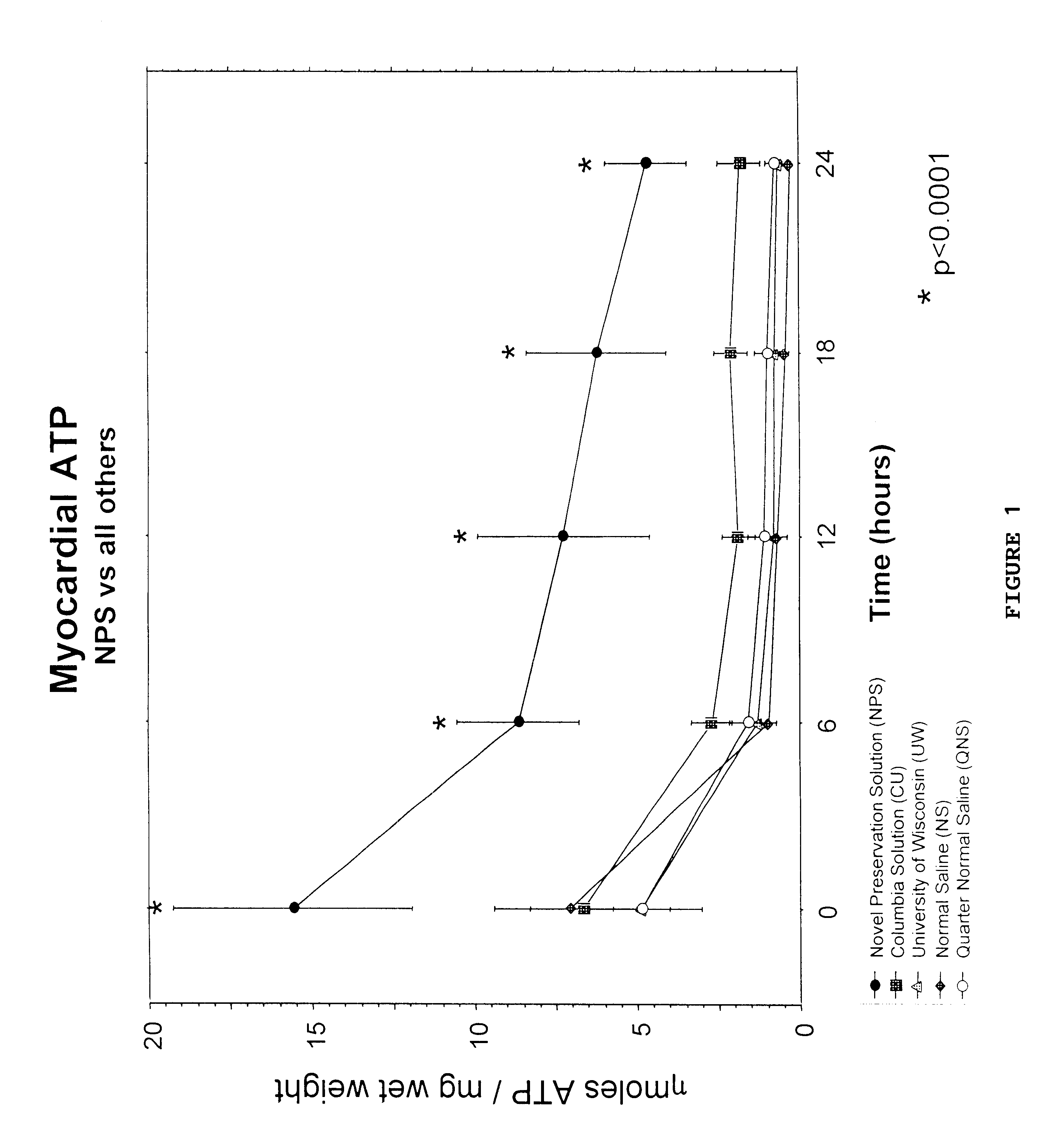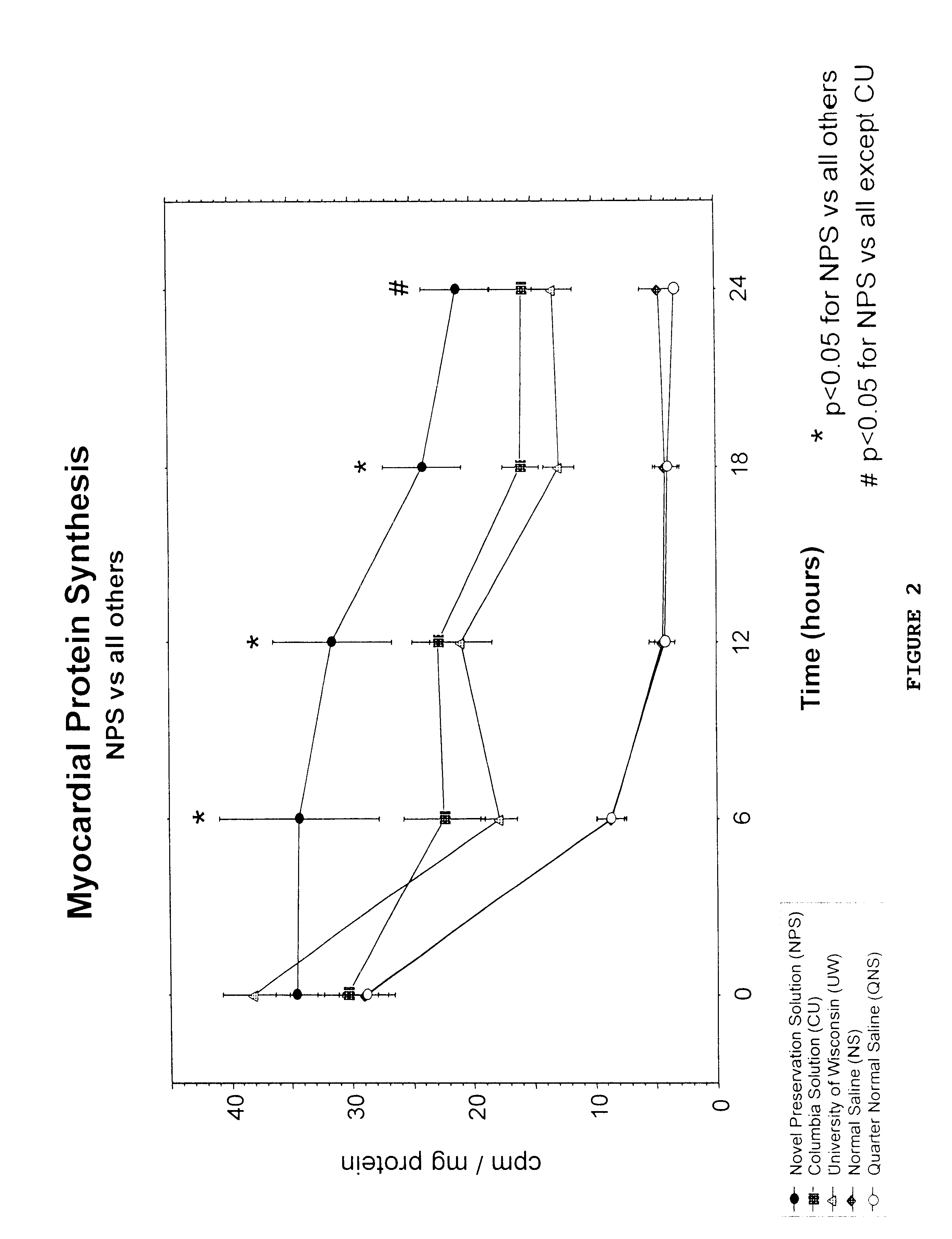Organ preservative solution containing trehalose, anti-oxidant, cations and an energy source
- Summary
- Abstract
- Description
- Claims
- Application Information
AI Technical Summary
Benefits of technology
Problems solved by technology
Method used
Image
Examples
example 2
Rat heart slices were obtained and preserved as above in Example 1. At time 0, six, twelve, eighteen, and 24 hours after slicing, six slices were removed from each of the preservative solutions and tested for protein synthesis.
Protein synthesis was measured by incorporation of radiolabeled leucine into acid precipitable proteins. Following cold storage, the slices were placed onto Teflon / titanium rollers, loaded into glass scintillation vials and incubated at 37.degree. C. in Waymouth's solution (Gibco, Grand Island, N.Y.) containing [.sup.3 H] Leucine (New England Nuclear, Boston, Mass.) at 0.3 mCi / ml (prepared with 60 ml [.sup.3 H] Leucine in 200 mls of Waymouth's solution for four hours in the Vitron dynamic organ incubator (Vitron, Tucson, Ariz.). The incubated slices were weighed, washed twice in buffer and homogenized in 1 ml of 1N KOH. Twenty ml aliquots of the homogenates were then pipetted off and 1 ml of 1.5N acetic acid added. The solution was then left to stand for 24 ho...
example 3
The performance of the novel preservation solutions of the invention on intact organs such as the heart are evaluated as follows. A perfusion circuit is established in which the functions of the heart and lung of the animal subject are managed by the circuit during the experimental procedures. Adult rabbits are used to provide a "donor" animal which supplies the heart and a "support animal" to support the heart on the circuit. All surgeries are performed aseptically using appropriate anesthesia. The anesthetic is selected to minimize cardiovascular side effects or myocardial depression, and thus is preferably not an inhalation anesthetic. The narcotic fentanyl is used in combination with droperidol and infused continually. Initial sedation and anesthesia are obtained using an intramuscular injection of 0.05 mg / kg fentanyl and 2.5 mg / kg droperidol.
The support animal is placed in the supine position, shaved, sterilely prepped, and a tracheostomy is performed. Mechanical ventilation is...
example 4
Rat lungs were dissected out from adult Sprague-Dawley rats. Agarose gel at 37.degree. C. is then instilled via the trachea to solidify the lung parenchyma. The solidified lung tissue is then precision cut using a mechanical tissue slicer (Vitron, Tucson, Ariz.) into 200 .mu.m diameter slices as described above for heart tissue in Example 1. The slices were preserved at 4.degree. C. in: 1) solution 1 ("Low Potassium-Dextran Solution")(refer to Table 5)(Keshavjee et al., J. Thorac. Cardiovascular Surg. 98:529-534 (1989)); 2) normal saline ("NS"); 3) UW (refer to Table 2); 4) Euro-Collins solution ("EC") (refer to Table 6) (Collins et al., Lancet 2:1219 (1969)); 5) Kyoto solution (refer to Table 7) (Wada et al., Ann. Thorac. Surg. 61:963-968 (1996)); or 6) the solution of this invention (m-US+c-GMP, refer to Table 4).
The following ingredients and amounts were used to prepare the lung solution of the invention:
The ingredients were added at room temperature using constant stirring. Afte...
PUM
 Login to View More
Login to View More Abstract
Description
Claims
Application Information
 Login to View More
Login to View More - R&D
- Intellectual Property
- Life Sciences
- Materials
- Tech Scout
- Unparalleled Data Quality
- Higher Quality Content
- 60% Fewer Hallucinations
Browse by: Latest US Patents, China's latest patents, Technical Efficacy Thesaurus, Application Domain, Technology Topic, Popular Technical Reports.
© 2025 PatSnap. All rights reserved.Legal|Privacy policy|Modern Slavery Act Transparency Statement|Sitemap|About US| Contact US: help@patsnap.com



